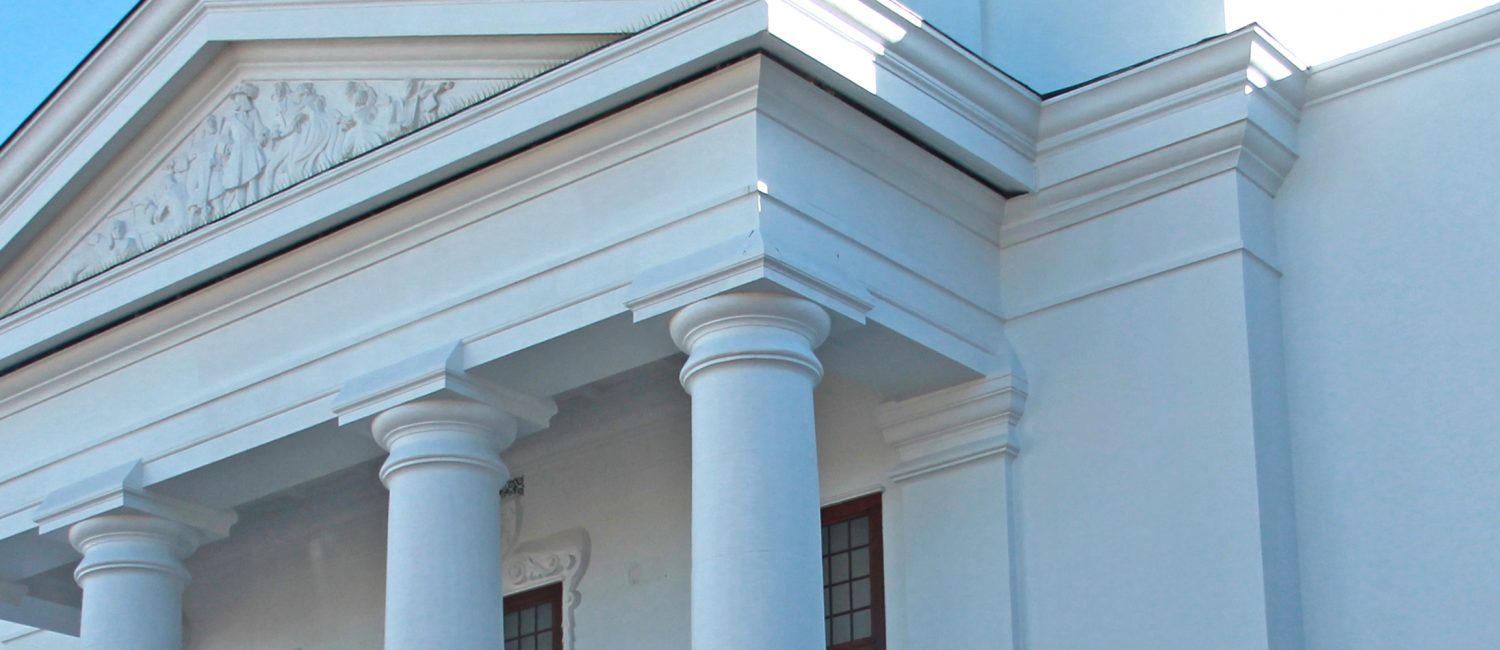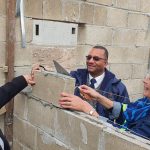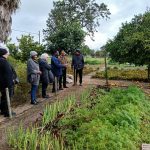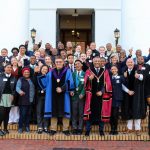The following speech was delivered by Executive Mayor Gesie van Deventer during the adoption of the 2022/23 Budget (MTREF) at a meeting of the Stellenbosch Council on 25 May 2022. Download a the full speech document by clicking here.

Speaker;
Deputy Mayor;
Chief Whip of the Ruling Party;
Members of the Mayoral Committee;
Ordinary members of Council;
Municipal Manager and Senior Management;
Ward Committee Members;
Members of the public;
Members of the media present;
All protocol observed
Good afternoon ladies and gentlemen,
Introduction
Creating and expanding sustainable Infrastructure to enable economic growth and creating job opportunities are the building blocks that form the foundation of our budget for 2022/23.
Speaker, as the Executive Mayor of Stellenbosch Municipality it is my responsibility and privilege to submit the budget for the new financial year of 2022/23 in accordance with section 23 of Municipal Finance Management Act.
It is with great pleasure that I motivate to and enlighten Council on the final budget for the 2022/2023 financial year. We have considered all inputs and comments we received from the greater Stellenbosch community, from the public participation process during April and throughout the past year.
Speaker, statistics shows that the whole of South Africa continues to face a triple challenge of Inequality, Poverty, and Unemployment.
It further shows our population is estimated at around 61 million people, of which 34% (20mil) are unemployed:
- Half of our population who start school, do not complete their schooling;
- A quarter of our population live below the poverty line;
- There are about 13 million applications for the R350.00 Social Grant;
- 8million of our population have never worked;
- More than 50% do not complete matric;
- 58% of all applicants are younger than 35; and
- 64% of our young people are unemployed.
A compounding factor is that over the medium term, transfers to Local Government are also reduced by R19.4 Billion, including R14.7 Billion from the Local Government equitable share.
Additional stress on the fiscus is placed by population growth in the Western Cape, has seen an increase of 44% over the period 2002 and 2020.The current Census will determine the correct data, but it is obvious to all who live in Stellenbosch that it has by now a population of just over 200 000.
While the City of Cape Town observed the highest population growth in the Western Cape in absolute terms, the West Coast, Cape Winelands and Overberg Districts experienced population growth of more than 40% over this period, with projections for the period 2020 to 2030 for Stellenbosch, estimated at around 40,623.
With significant population growth, comes an increased demand for infrastructure upgrading, job creation opportunities, stable economic growth and sustainable tourism industries.
The result is that what we are dealing with is an enormous increase in demand and a huge decrease in available funds.
Speaker, while our country has seen a decrease in COVID infections and relaxed restrictions in terms of the COVID preventative measures, our country has a long way to go to heal economically.
The past two years of Covid-19 lockdowns has had a significant impact on our budget, and this impact cannot be understated. Numerous projects had to be paused to accommodate the impact of this and also to make money available for Covid-19 control measures.
We have to work smarter and more innovative with our budget, but we also have to be realistic about the money available. It is definitely not business as usual.
Speaker, the Municipal Manager and the Chief Financial Officer, in accordance with their mandate streamlined the compilation of the budget in consultation with the Executive Mayor.
OPERATING BUDGET – REVENUE
The anticipated overall revenue budget increase was limited to 6.62% resulting in annual operating revenue increasing from R2 116 590 768 in 2021/2022 to R2 256 812 246 in 2022/2023. This reflects the inflation expected over the financial year and does not constitute a real increase or profit margin.
Taking cognisance of the economic conditions, the resultant low employment levels and levels of disposable income, it was important to keep services as affordable as possible by critically looking at the costs associated with providing the service.
Accordingly, management investigated potential pitfalls. It was found amongst others that spiralling expenditure on employee costs did not keep trend with realistically anticipated revenue streams, compounded by the decline in electricity surpluses as a result of higher input costs to provide the service.
Speaker, sadly we have no control over these factors as these are nationally determined.
The increase in the various revenue categories is reflected herein.
| REVENUE CATEGORIES | 2021/2022 | 2022/2023 |
| Property Rates | 415,667,656 | 438,941,448 |
| Electricity | 787,275,170 | 846,763,143 |
| Water | 166,399,723 | 176,782,707 |
| Sewerage | 102,956,558 | 109,133,951 |
| Refuse | 87,936,447 | 94,971,363 |
| Rental of facilities | 10,811,501 | 15,537,894 |
| Fines | 120,164,832 | 124,955,174 |
| Licences and Permits | 5,778,049 | 5,934,010 |
| Operational + Capital grants | 337,576,396 | 366,410,000 |
| Other Income | 82,024,436 | 77,382,556 |
| Operating Revenue | 2,116,590,768 | 2,256,812,246 |
The following pie chart explains the various contributions. As Stellenbosch Municipality has a percentage of high value properties it contributes a big portion of our income. It is important to retain this income stream in order to assist us in delivering services to the bigger Municipality.
Speaker, considering all the facts set out herein above, the proposed tariffs for the new financial year is the following:
| Average tariff increases | 2022/23 | |
| Property Rates | 6.20% | |
| Electricity | 7.90% | |
| Water | 6.20% | |
| Sanitation | 6.50% | |
| Refuse Removal | 8.00% |
It is however important to note that the proposed revenue as per table A4 (Appendix 1 – Part 1 – Section D) is based on the realistic anticipated income to be derived in 2022/2023
Rates
- In the 2022/2023 financial year, the Property Rates Tariff paid by owners will increase with 6.20%, whilst total rates also increased with 6.20%.
- The increase in total rates reflects the increase in property values as determined by interim valuations that were performed.
- It is important to stress that this four-yearly process is compulsory and done in terms of the Municipal Property Rates Act 6 of 2004 (the MPRA) by independent valuers appointed through a regulated tender process prescribed by the relevant Act.
- To assist our vulnerable citizens, rates rebates to senior citizens and disabled persons are also available as per the requirements of Council’s amended Rates Policy to qualifying ratepayers with a monthly income of R15 000 or less.
Electricity
Speaker it is important to note that electricity prices are regulated by NERSA, a national competency.
- According to NERSA, the inclining block rate tariff structure they now use, is commonly used to charge for water usage.
- The feature of this tariff structure is that the more you use, the higher the average price.
- The objective of the inclining block tariff is to provide protection for lower usage customers against high price increases resulting in a reduction in tariffs to these customers and to motivate lower usage.
- This means that higher consumption customers will see increasingly punitive charges based on their electricity usage.
- The Municipality is implementing the directive from NERSA as part of the Municipality’s Licensing Agreement and as a result had to deal with the negative impact of a declining Electricity surplus, year-on year, putting more pressure on the level and quality of services provided.
- Council’s attention is further drawn to the fact that the proposed electricity tariff is of 7.90% is lower than the increase in electricity bulk purchases for the 2022/2023 financial year of 8.61% as approved by NERSA (National Electricity Regulator of South Africa) for implementation by all Municipalities.
- Although the proposed tariffs increase with only 7.90%, the Municipality is experiencing a decrease in electricity demand as consumers are utilising alternative energy sources. This has an impact on our revenue as we still have to maintain the same infrastructure, but get lesser income.
Water
- Taking cognizance of the challenges that the Province is facing as a water scares Province, and an anticipated dry winter associated with climate change, the plight of the poor and the affordability of basic services, the average tariff increase for the rest of the consumptive water scales is 6.20%.
- The tariff is designed to cater for current and future capital investment in basic water infrastructure.
Sewerage (Sanitation)
- The proposed increase in this tariff is 6.50%. Sanitation services is classified as an economical service.
- This means that the service charges for sanitation must cover the cost of providing the service, i.e. it must at least break even.
- This proposed tariff increase is necessitated by operational requirements, maintenance of existing aging infrastructure, new infrastructure financing/provision and to ensure that the service is delivered in a sustainable manner.
Speaker we all are aware of the sanitation challenges in the Municipal area and have to address it.
Refuse (Solid Waste)
Speaker the present pattern of littering and dumping of waste is a huge burden on our budget and we simply have to get our residents to minimise this evil as it absorbs budget resources that should be used for upliftment of our communities.
The total cost of refuse removal has to include ongoing removal on a daily basis of illegal dumping all over the Municipality.
It includes not only truck and equipment, but also necessitates additional staff and offices. Speaker this needs innovative solutions urgently. I appeal to all councillors to assist in getting our communities to work with us to reduce this evil.
Refuse removal services, like sanitation are also classified as an economical service.
- This means that the service charges for refuse must cover the cost of providing the service, i.e. it must at least break even.
- The Municipality will implement an above inflation tariff increase as this service does not break even and to provide for the additional expenditure for the transport of the waste from the Stellenbosch Landfill Site.
- The solid waste tariffs were modelled to give effect to the principle of the service charge being cost reflective as the service cannot be cross-subsidized. It is proposed that the tariff increases by 8.00% as a result of the before mentioned. It is however lower than last year’s increase, which was 12%.
- The very nature of this tariff, which we want to keep as low as possible to assist our residents, does not lend it to financing the expansion of the landfill site and therefore the proposed extension by way of constructing the new cell, was funded from council’s own reserves.
Rental of facilities
- With the lifting of the national state of disaster and the relaxation of the COVID restrictions, we again opened all recreation facilities and we expect the income from rental of facilities to increase substantially in the next financial year.
Debt Management
Speaker it is important to note that the executing of all credit control and debt collection procedures are carried out in terms of the prescribed approved Credit Control and Debt Collection policy.
- These procedures followed include the disconnection of services, where there are services that can be disconnected, the issuing of final notices, the conclusion of reasonable agreements where the settlement of the accounts is not possible and also the follow up on defaulting debtors not honoring arrangements.
- The Municipality has to enforce the above procedures to ensure that debt which is collectable is collected and all debt that is regarded as not recoverable, be written off.
- It is important that every resident contributes what they are required to in terms of the policy, otherwise only some residents carry the burden. Therefore, the Municipality developed a revenue enhancement strategy.
- The document focuses on the formulation and implementation of strategies to improve financial management and controls within the Municipality.
- The objective of any successful revenue enhancement strategy is to build and improve on current payment levels and then to recover arrear debt.
- The Municipality has also promulgated the Credit Control and Debt Collection By-Law on the 4th of March 2011 to strengthen the internal credit control and debt collection procedures through handing over of all debt over 90 days to the appointed attorneys.
- Unfortunately, a zero-tolerance approach has be followed where consumers are able to pay for services, as a lack of income indirectly denies paying consumers the level and standard of service that they are entitled to.
- Speaker the bottom line is, residents need and ask for excellent services, but this can only be done if we have the necessary income.
- Where else must the money come from? Or do we want to slide into a deterioration of services, as in many other Municipalities.
OPERATING BUDGET – EXPENDITURE
The budget sees an increase in annual operating expenditure from R1 977 679 012 in 2021/2022 to R2 102 064 809 in 2022/2023. This 6.29% increase is primarily due to increases in several expenditure categories, examples which are included in the table below:
| EXPENDITURE CATEGORIES | 2021/2022 | 2022/2023 |
| Employee Related Costs | 578,245,894 | 624,463,763 |
| Remuneration of Councillors | 20,059,305 | 21,062,270 |
| Depreciation & Impairment | 211,541,195 | 213,118,310 |
| Finance Charges | 44,976,262 | 67,799,365 |
| Bulk Purchases Electricity | 507,699,460 | 551,412,384 |
| Other Expenditure | 615,156,896 | 624,208,717 |
| Total Expenditure | 1,977,679,012 | 2,102,064,809 |
Council must note the upward pressure of external borrowing interest (Finance Charges) on future tariffs.
In this regard, strong political will and strategic leadership is required to ensure that the Municipality maintains the position of being responsive to its communities by ensuring that service charges are kept as affordable as possible and realistic by amongst other, critically investigating funding choices and expenditure decisions.
Explanation of significant expenditure variances:
Finance Charges
- The interest payable for the 2022/2023 financial year has been calculated on the maximum amount of possible borrowings drawn down up to the end of the 2022/2023 financial year.
Bulk Purchases
- The Municipal tariff guideline increase issued by NERSA setting the bulk purchase increase at 8.61%.
Other expenditure
- Budgetary constraints and economic challenges meant that the Municipality had to apply a combination of cost-saving interventions.
- These interventions include amongst other, measures to limited telephone usage and filling of critical vacancies that will result in a decrease in consulting fees.
CAPITAL BUDGET
- The implementation of our capital budget has proven to be a challenge due to the uncertainty around the validity of the Preferential Procurement regulations and the confusion that was created by the various advisory notes, had a major impact on the implementation of our capital budget.
- This delayed the implementation of the capital budget with a month and will have a negative impact on the capital expenditure percentage for this financial year.
Speaker the capital budget increases from R 403 507 636 in 2021/2022 to R409 273 204 in 2022/2023. This slight increase was planned purposefully as we need to stabilise our borrowing and minimise our interest, post Covid. We are however still able to expand our infrastructure substantially.
The following table explains how we achieve this:
| DIRECTORATE | 2021/2022 | 2022/2023 |
| Municipal Manager | 44,000 | 40,000 |
| Planning and Economic Development | 17,209,720 | 15,185,000 |
| Community and Protection Services | 38,617,860 | 26,850,958 |
| Infrastructure Services | 317,662,137 | 325,047,246 |
| Corporate Services | 29,573,919 | 41,900,000 |
| Financial Services | 400,000 | 250,000 |
| Total Expenditure | 403,507,636 | 409,273,204 |
The funding of this budget was also balanced carefully to minimise loans. Thus, we were able to save interest and make more money available for spending:
Speaker, for the information of council, I hereby highlight the following capital projects above R50 Million included in the three-year MTREF
| Project Description | 2022/2023 | 2023/2024 | 2024/2025 | MTREF Total |
| Bien don 66/11kV substation new | 2 600 000 | 25 000 000 | 25 000 000 | 52 600 000 |
| Expansion of the landfill site (New cells) | 44 000 000 | 41 000 000 | – | 85 000 000 |
| New Reservoir & Pipeline: Vlottenburg | 20 569 470 | 39 000 000 | 45 000 000 | 104 569 470 |
| Upgrade of WWTW Wemmershoek | 17 500 000 | 17 500 000 | 17 500 000 | 52 500 000 |
| 84 669 470 | 122 500 000 | 87 500 000 | 294 669 470 |
Speaker, I now highlight the major capital expenditure planned in the following areas during the 2022/2023 financial year:
- I cannot help but be reminded of the parable in the Bible that tells of the house built on rock versus the house built on sand.
- With no solid foundation, any other projects and plans cannot succeed.
- This is reflected in the following examples of what we have budgeted for the next three-year budget cycle:
Water:
| Name | Region benefiting | MTREF Total |
| Bulk Water Supply Klapmuts | Klapmuts | 5 000 000 |
| Bulk Water Supply Pipe and Reservoir: Kayamandi | Kayamandi | 41 500 000 |
| Bulk Water Supply Pipe Line & Pumpstations: Franschhoek | Franschhoek | 10 000 000 |
| Bulk Water Supply Pipeline & Reservoir – Jamestown | Jamestown | 21 500 000 |
| Chlorination Installation: Upgrade | Whole of Municipality | 5 000 000 |
| Dwarsriver Bulk Supply Augmentation and Network Upgrades | Kylemore | 7 550 000 |
| New Developments Bulk Water Supply WC024 | Whole of Municipality | 6 500 000 |
| New Reservoir & Pipeline: Vlottenburg | Volttenburg | 104 569 470 |
| Upgrade and Replace Water Meters | Whole of Municipality | 5 000 000 |
| Water Conservation & Demand Management | Whole of Municipality | 6 000 000 |
| Water Telemetry Upgrade | Whole of Municipality | 500 000 |
| Water Treatment Works: Idasvalley | Idas Valley | 4 000 000 |
| Waterpipe Replacement | Whole of Municipality | 2 000 000 |
Sanitation:
- The upgrading of the various WWTW are especially important as these communities continue to expand and grow and the existing infrastructure is not sufficient to meet their needs.
- This contributes to our commitment to be a green valley and provide dignified living spaces to all residents.
| Name | Region benefiting | MTREF Total |
| New Development Bulk Sewer Supply WC024 | Whole of Municipality | 5 000 000 |
| Sewerpipe Replacement: Dorp Straat | Onder Papegaaiberg | 20 000 000 |
| Sewerpipe Replacement | Whole of Municipality | 12 000 000 |
| Upgrade of WWTW: Pniel & Decommissioning of Franschhoek | Pniel | 14 000 000 |
| Upgrade of WWTW: Klapmuts | Klapmuts | 16 000 000 |
| Upgrade of WWTW Wemmershoek | Mooiwater | 52 500 000 |
| Extention Of WWTW: Stellenbosch | Onder Papegaaiberg | 6 000 000 |
| Refurbish Plant & Equipment – Raithby WWTW | Whole of Municipality | 7 000 000 |
| Kayamandi Bulk Sewer | Kayamandi | 5 000 000 |
Human Settlements:
- Housing opportunities remains a top priority for many residents, especially our poorer communities.
- It provides, safety and security and creates an asset that allows greater economic freedom.
- Housing however remains a challenge, as the resources and allocations from National and Provincial Government remains limited and the backlog tremendous.
- However, the following has been budgeted for housing projects over the next 3 years to create more housing opportunities:
| Name | Region benefiting | MTREF Total |
| Housing Projects | Langrug | 4 000 000 |
| Cloetesville (380) FLISP | Cloetesville Ward 17 | 1 100 000 |
| Cloetesville Infill (738) FLISP | Cloetesville Ward 16 & 17 | 850 000 |
| Erf 64, Kylemore | Kylemore | 6 225 000 |
| Erf 7001 and other possible sites for mix-used development in Cloetesville | Cloetesville Ward 17 | 1 050 000 |
| Erven 81/2 and 82/9, Stellenbosch | Kayamandi | 875 000 |
| Jamestown: Housing | Jamestown | 13 928 000 |
| Kayamandi Town Centre | Kayamandi | 15 000 000 |
| Kayamandi Watergang Northern Extension (2000) | Kayamandi | 5 700 000 |
| Klapmuts La Rochelle (100) | La Rochelle Informal Settlements | 433 000 |
| La Motte Old Forest Station (±430 services & ±430 units) | La Motte | 1 250 000 |
| Lapland Precinct | Tenantville | 1 000 000 |
| Stellenbosch Adam Tas Transit Oriented Development (3500) | Whole of Municipality | 3 500 000 |
The FLISP grant is for the next phase of the Ida’s Valley housing project. We have been very fortunate to receive the necessary grant funding to make this possible.
Upgrades:
- Although housing opportunities remain limited, as a Municipality we are committed to improve the living conditions for our residents.
- That is why we are making provisions in the budget to improve the living conditions for residents, making sure that the can live in dignity and addressing inequality over the next 3 years for our residents in informal settlements:
| Name | Region benefiting | MTREF Total |
| Kayamandi Watergang Northern Extension (2000) | Kayamandi | 5 700 000 |
| Mini Waste drop-off facilities at Inf Settlements | Whole of Municipality | 400 000 |
| Electrification INEP | Franschhoek | 12 269 000 |
| Kayamandi: Zone O (±711 services) | Kayamandi | 19 350 000 |
| Langrug Franschhoek Mooiwater Dam Rehab & Basic Services | Wemmershoek | 19 680 000 |
| Upgrading of The Steps/Orlean Lounge | Cloetesville | 3 500 000 |
| Franschhoek Sewer Network Upgrade (Langrug/Mooiwater) | Whole of Municipality | 12 000 000 |
| Stormwater Drainage – Kayamandi and Enkanini | Kayamandi | 4 276 665 |
| Stormwater Retention Facilities | Whole of Municipality | 1 500 000 |
Safety and security:
- This is of utmost importance to all our residents and has been highlighted by both the President and the Premier during their respective speeches earlier this year.
- The Provincial Government has made significant commitments to improve safety across the province.
- We also recently opened our state-of-the-art Control Room and continue with the installation of our cameras across the Municipality;
- With already more than 300 cameras installed, and more than 40 Neighbourhood watches registered we are committed to the safety of our residents;
- We are falling in line with this and have made the following provisions for the next three years:
| Name | Region benefiting | MTREF Total |
| Ad-Hoc Provision of Streetlighting | Whole of Municipality | 8 042 375 |
| Bicycle Lockup Facilities | Whole of Municipality | 600 000 |
| Fencing of Netball Courts | Whole of Municipality | 350 000 |
| Fencing: Sport Grounds (WC024) | Whole of Municipality | 1 750 000 |
| Botmaskop: Security Fencing | Botmanskop | 3 500 000 |
| Fencing: Parks and Gardens | Whole of Municipality | 400 000 |
| Fire Station – Jamestown | Jamestown | 1 500 000 |
| Install and Upgrade CCTV/ LPR Cameras in WC024 | Whole of Municipality | 4 000 000 |
| Neighborhood Watch Safety equipment | Whole of Municipality | 1 000 000 |
| Vehicle Fleet: Law Enforcement | Whole of Municipality | 2 500 000 |
Roads and traffic
- We will also invest in infrastructure related projects over the next 3 years that will assist in improving road safety as well as improving traffic conditions in our towns of all residents:
| Name | Region benefiting | MTREF Total |
| Lanquedoc Access road and Bridge | Johannesdal | 20 000 000 |
| Reseal Roads – Klapmuts & Surrounding | Klapmuts | 1 250 000 |
| Reseal Roads – Kylemore & Surrounding | Meerlust | 1 500 000 |
| Reseal Roads – Stellenbosch & Surrrounding | Whole of Municipality | 14 000 000 |
| Reseal Roads – Franschhoek & Surrrounding | Franschhoek | 2 000 000 |
| Jamestown Transport Network | Jamestown | 6 000 000 |
| Main Road Intersection Improvements: Franschhoek | Franschhoek | 15 129 950 |
| Main road intersection improvements: Helshoogte rd/La Colline | La Motte | 6 000 000 |
| Main Road Intersection Improvements: R44 / Merriman Street | Whole of Municipality | 5 000 000 |
| Main Road Intersection Improvements: Strand / Adam Tas / Alexander | La Colline-Faure | 5 000 000 |
| Pedestrian Crossing Implementation | Whole of Municipality | 600 000 |
| Raised Intersection Implementation | Whole of Municipality | 1 200 000 |
| Road Safety Improvements | Whole of Municipality | 500 000 |
| Traffic Signal Control: Installation and Upgrading of Traffic Signals and Associated Components | Whole of Municipality | 2 500 000 |
| Pedestrian Streets in Stellenbosch | Whole of Municipality | 1 700 000 |
Cleaner communities and environment:
- Clean, healthy and environmentally sustainable towns are a priority as we plan for the future and well-being of our valley.
- We are continuing our work to expand our landfill site, and have opened our new Material Recovery Facility, of which we are exceptionally proud.
- We have a responsibility towards our environment to think differently about waste management and apply more environmentally sound and safe solutions.
- Reduce, reuse and recycle remains our focus over the next few years in an effort to promote our goal as a green valley and to become part of the green economy.
- To continue this essential service for the next three years we have budgeted as follows:
| Name | Region benefiting | MTREF Total |
| Expansion of the landfill site (New cells) | Whole of Municipality | 85 000 000 |
| Formalize skip areas | Whole of Municipality | 500 000 |
| Skips (5,5Kl) | Whole of Municipality | 500 000 |
| Street Refuse Bins | Whole of Municipality | 500 000 |
| Transfer Station: Stellenbosch Planning and Design | Whole of Municipality | 1 000 000 |
Load Shedding
Speaker, these initiatives also ties in with our exciting plans to rid the greater Stellenbosch of the effects of loadshedding.
- Speaker, electricity is an absolute necessity for all our residents to live in safety and dignity and for economic growth. Load shedding has a devastating effect on all our communities and our economy.
- We have decided enough is enough and intend to rid our Municipality over time of the disastrous effect of load shedding.
- We have already done the preliminary research and also signed an MOU with the Stellenbosch University and CSIR. We shall be responsible, but continue steadfast with this process.
- Speaker, if you will allow me to brag a bit, we have also completed the first phase of installing solar panels on our Municipal buildings, and these will be officially switched on, on 01 June 2022;
- While this is just a small drop in the bucket, we remain committed to rid our beautiful Municipality of this disaster;
- As we step up this process, we also need to ensure that our existing electrical infrastructure is sufficient and well maintained to continue to provide essential services.
- It is also vital as we continue to rebuild our economy after the pandemic.
- As we continue to explore alternative energy resources like waste to energy and landfill gas to energy we will have also budgeted R18 million over the next three years for alternative energy sources including the installation of solar panels.
- As we make progress in our mission to eradicate load shedding, we will be closely watched by other Municipalities and stakeholders on the progress we make.
- We are therefore making the following provisions over the next 3 years:
| Name | Region benefiting | MTREF Total |
| Landfill Gas to Energy | Whole of Municipality | 25 000 000 |
| Waste Biofuels | Whole of Municipality | 300 000 |
| Waste Management Software | Whole of Municipality | 200 000 |
| Waste Minimization Projects | Whole of Municipality | 500 000 |
| Waste to Energy – Implementation | Whole of Municipality | 5 300 000 |
Sport facilities and parks:
- Creating opportunities for especially the youth through sport and recreation is very important.
- Sport has the ability to unite, uplift and create opportunities in a unique and positive way.
- Through the course of the next three years we are investing in the upgrading of various sport facilities, equipment as well as maintaining existing facilities.
| Name | Region benefiting | MTREF Total |
| Jonkershoek Picnic Site upgrades | Jonkershoek Area | 750 000 |
| Kayamandi Sports Ground | Kayamandi | 300 000 |
| La Motte Open Air Gym | La Motte | 300 000 |
| Upgrade of Sport Facilities | Whole of Municipality | 10 122 060 |
| Upgrading of Parks | Whole of Municipality | 1 165 928 |
Transport:
- A large number of residents rely on public transport.
- Although roads are mostly a Provincial mandate, it is also important to reduce congestion on our roads.
- To work towards better and safer transport opportunities for our people over the next 3 years, we have budgeted for public transport as follows:
| Name | Region benefiting | MTREF Total |
| Jamestown Transport Network | Jamestown | 6 000 000 |
| Traffic Calming Projects: Implementation | Administration: Head Office | 600 000 |
| Traffic Management Improvement Programme | Whole of Municipality | 2 000 000 |
| Comprehensive Integrated Transport Plan | Whole of Municipality | 1 800 000 |
| Non-Motorised Transport Implementation | Kayamandi Ward 13, 14 &15 | 2 000 000 |
| Park and Ride (Transport Interchange) | Whole of Municipality | 500 000 |
| Re-design of Bergzicht Public Transport Facility | Whole of Municipality | 2 500 000 |
Speaker to sum up, it is clear that the greatest part of our capital budget expenditure is geared towards infrastructure.
- This is done, with the goal of excellent service delivery for all residents in mind and also to create greater long-term sustainability, equality, economic opportunities and dignified living conditions for especially our disadvantaged residents.
- In this regard, I would like to highlight our financial support structure to assist our indigent communities.
Financial Support
- Speaker, Stellenbosch Municipality does provide free basic services to poor households as a means of poverty alleviation. We mainly provide support to households who are unable to pay or struggle to pay for their basic services.
- This includes households with an income base below a determined threshold (two times the government social grant paid to a pensioner plus 25%), to the unemployed, child-headed households, retired persons and disabled persons.
- These consumers must apply to be registered as an indigent household on our indigent register in order to obtain this benefit or to qualify for rebates from their Municipal basic services or property rates levied.
- Indigent households in 2022/2023 will receive:
- 100 units of free electricity per month;
- 6 kilolitres of free water per month,
- free refuse removal services,
- free sanitation services.
- This indigent subsidy will be credited to the customer’s account during the monthly billing run. The indigent subsidy is funded through our equitable share allocation.
- It is important to note that it is expected from indigent households only to pay for electricity consumption above 100 units of electricity per month and only for water consumption above 6 kilolitres of water per month.
- For the 2022/2023 financial year the qualifying criteria for indigent status is households (main bread winner/s) earning less than R 6,500 per month as indicated by the Municipality’s amended Indigent Policy.
- The percentage rebate granted to senior citizens and disabled persons based on the different monthly household income levels will be determined according to the schedule below.
- The income bands and rebates (senior citizens and disabled persons) for the effective financial period of this Policy are as follows:
| Gross Monthly Household Income | % Rebate | |||
| Income bands | ||||
| Up to | 8 000 | 100% | ||
| From | 8 001 | To | 10 000 | 75% |
| From | 10 001 | To | 12 000 | 50% |
| From | 12 001 | To | 15 000 | 25% |
EPWP
- Speaker, The Municipality also succeeded in accessing the EPWP Incentive Grant for Municipalities in a bid to give some relief to the poorest of the poor by means of contract employment opportunities over the short term. The allocation for the 2022/23 financial year is R 4 928 000.
CLOSING
- Speaker, it is clear from what I have presented here today that we are focused and committed to our mandate to serve and to provide the necessary services, opportunities and development that our residents deserve and need;
- Bradley Vinson once said – “Money is a tool. Used properly it makes something beautiful; used wrong it makes a mess”
- Speaker, in closing I am deeply grateful for the invaluable inputs and feedback that we received from all stakeholders – the most important stakeholders, being our residents.
- These inputs, needs of the community and development requirements of our Municipality inform this budget that’s being tabled today.
- It’s only through our amazing IDP process that we can comfortably table this budget, ensuring that it speaks to the needs of our communities;
- Furthermore, assuring them that we’ve listened to them;
- Baie dankie, Thank you very much, Enkosi kakhulu.







